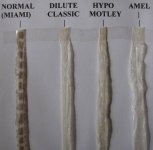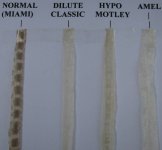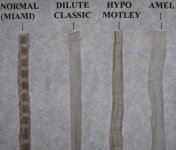I did a shed/skin comparison between a Normal (Miami), a Dilute Classic, a Hypo Motley, and an Amel.
This was done because Dilutes shed skin that is pigment free (akin to an Amel) and, since Hypos can have near pigment free skin, I didn't think that pigment free skin (on a snake other than Amel) could be a conclusive determination as to whether, or not, a snake was a Dilute ... but that it could, certainly, be used as a ~tool~ for identification. However, taking into consideration as to how distinct the Dilutes' pigment free skin are, I decided to see if it could be differentiated from that of Hypo.
Thus, my digging this thread back up.
I still think, at this time (without further study/comparisons), that it should only be used as a tool but, ... in this sample, it is quite clear that the Dilute's shed skin can be differentiated from that of a Hypo (Although a Hypo's skin can appear to be pigment free, to the naked eye, it is not).
Compared to the Amel, there is no outstanding difference between it and the Dilute's skin.
Comparing a Dilute Classic's skin, to a regular Classic/Normal, there is a very notable difference.
I did not include a Lavender's shed skin (in the photos) but a difference can be noted between it, and a Dilute's shed skin, as well. Lavenders do not have the amount of pigment that a Normal/Classic does ... they tend to lean more towards the shed skins, of Hypos, rather than toward the opposite extreme (that of Normals). I mention this because, although I did not include a Lav's skin, in the photos, I did check to see the difference between it and a Dilute.
The difference/s can best be appreciated when skins are side by side and, especially, IRL.
However, I am hoping this helps in some way or another.
The following photos are the comparisons.
All three pics taken under different lighting conditions ... with the 3rd photo having light going through the paper that the skins are attached to.
Keep in mind that the Amel's skin is just a wee bit larger, than the other three, and, so, the scales/spacing are a tad larger (imagine a group of small windows, vs. the same amount of windows that are just a bit bigger, and the different visual effects they could bring).
This was done because Dilutes shed skin that is pigment free (akin to an Amel) and, since Hypos can have near pigment free skin, I didn't think that pigment free skin (on a snake other than Amel) could be a conclusive determination as to whether, or not, a snake was a Dilute ... but that it could, certainly, be used as a ~tool~ for identification. However, taking into consideration as to how distinct the Dilutes' pigment free skin are, I decided to see if it could be differentiated from that of Hypo.
Thus, my digging this thread back up.
I still think, at this time (without further study/comparisons), that it should only be used as a tool but, ... in this sample, it is quite clear that the Dilute's shed skin can be differentiated from that of a Hypo (Although a Hypo's skin can appear to be pigment free, to the naked eye, it is not).
Compared to the Amel, there is no outstanding difference between it and the Dilute's skin.
Comparing a Dilute Classic's skin, to a regular Classic/Normal, there is a very notable difference.
I did not include a Lavender's shed skin (in the photos) but a difference can be noted between it, and a Dilute's shed skin, as well. Lavenders do not have the amount of pigment that a Normal/Classic does ... they tend to lean more towards the shed skins, of Hypos, rather than toward the opposite extreme (that of Normals). I mention this because, although I did not include a Lav's skin, in the photos, I did check to see the difference between it and a Dilute.
The difference/s can best be appreciated when skins are side by side and, especially, IRL.
However, I am hoping this helps in some way or another.
The following photos are the comparisons.
All three pics taken under different lighting conditions ... with the 3rd photo having light going through the paper that the skins are attached to.
Keep in mind that the Amel's skin is just a wee bit larger, than the other three, and, so, the scales/spacing are a tad larger (imagine a group of small windows, vs. the same amount of windows that are just a bit bigger, and the different visual effects they could bring).



